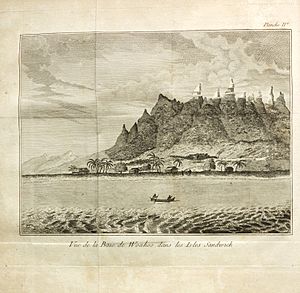George Dixon (Royal Navy officer) facts for kids
Quick facts for kids
George Dixon
|
|
|---|---|
| Born | 1748 Kirkoswald, Cumbria |
| Died | 11 November 1795 (aged 46–47) Bermuda |
| Allegiance | |
| Service/ |
|
| Years of service | c. 1776–1791 |
| Commands held |
|
George Dixon (1748 – 11 November 1795) was an English sea captain and explorer. He was also a fur trader, which meant he traded animal furs from the sea. George Dixon was born in a place called Kirkoswald in Cumbria, England. He was baptized there on July 8, 1748.
Contents
Early Life and Voyages
Serving with Captain Cook
George Dixon started his career in the Royal Navy. He sailed with the famous Captain Cook on his third big voyage. Dixon worked as an armourer on Cook's ship, the HMS Resolution. During this trip, he saw how much money could be made by trading furs along the North West Coast of America.
A Forgotten Explorer
Even though Dixon sailed with Captain Cook, he is not as well-known as other explorers. History books often don't mention him much. When they do, he is usually seen as a small part of bigger stories. People like Cook and William Bligh (who was also on Cook's third trip) are often remembered more.
Fur Trading Adventures
The Etches Company
After his time with Cook, George Dixon became interested in the fur trade. He joined a group of merchants called Richard Cadman Etches and Company. This group was also known as the King George's Sound Company. Their goal was to trade furs in what is now British Columbia and Alaska.
Sailing the Queen Charlotte
In September 1785, Dixon and another trader, Nathaniel Portlock, left England. Portlock commanded a larger ship called the King George. Dixon was the captain of the Queen Charlotte. His ship was smaller, with a crew of 33 people. Dixon and Portlock sailed together for most of their three-year journey.
Discoveries and Explorations
Exploring the Pacific Coast
In the summers of 1786 and 1787, Dixon explored the coasts of today's British Columbia and southeastern Alaska. He spent the winter between these years in the Hawaiian Islands. There, he was the first European to visit the island of Molokaʻi. He even anchored in Kealakekua Bay, where Captain Cook had been killed. However, Dixon did not go ashore.
Naming New Places
Dixon explored many important areas. These included Haida Gwaii (also known as the Queen Charlotte Islands), Queen Charlotte Sound, Yakutat Bay, Sitka Sound, and the Dixon Entrance. He was not the first European to visit Haida Gwaii. But he was the first to realize that these were separate islands, not part of the mainland.
On the northwestern part of Graham Island, he traded with the Haida people of Kiusta. He got many sea otter cloaks from Chief Cuneah. Because of all the cloaks, he named the bay where he stopped "Cloak Bay".
Later Life and Legacy
Publishing His Book
After his trading voyage, Dixon sailed to China to sell his furs. He then returned to England in 1788. In 1789, he published a book called A Voyage Round the World, but More Particularly to the North-West Coast of America. The book included descriptions written by his cargo officer, William Beresford. It also had valuable maps and extra information from Dixon himself.
Suggesting Settlements
Dixon was worried that other countries like Russia, America, or Spain might take over the North West Coast. In 1789, he met with important officials in England. He suggested that Britain should set up settlements there. He believed this would help Britain keep control of the coast and its valuable fur trade. He even suggested the Queen Charlotte Islands as the best place for a settlement.
Final Years in Bermuda
In February 1794, George Dixon moved to Bermuda with his wife, Ann. He planned to go back to his original job as a silversmith and jeweler. An advertisement in The Bermuda Gazette in April 1794 announced his new business. Sadly, his wife Ann died in childbirth in May 1794. She was buried in St George, Bermuda. Dixon was left with their only child, Marianna. George Dixon himself died shortly after, on November 11, 1795, in Bermuda.
See also
 In Spanish: George Dixon para niños
In Spanish: George Dixon para niños


